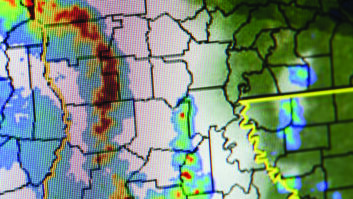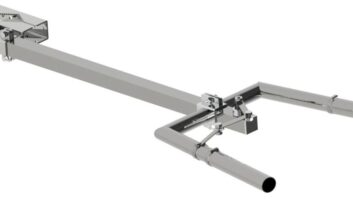The author is vice president of business development for Orban Labs Inc.
Over the last 20 years or so, I have put in several FM master antenna systems in various broadcast facilities, to drive everything from off-air monitors to test equipment to radios and receivers located throughout management offices and cubical farms. Some of those sites also had AM master antenna systems for off-air monitoring and feeding EAS receivers, but they were completely separate systems.
Fast forward a couple of decades, and the subject of master antenna systems presents itself once again; this time, the concept of having a single system with both AM and FM on a single coax gets a closer look.

Fig. 1: System block diagram.
DaySequerra purchased Orban in July 2016 and was in the process of moving to a new building in Pennsauken, N.J. The new facility needed a master antenna system, preferably one that would combine both AM and FM into a single cable distribution system to feed 16 to 24 devices.
I first created a general block diagram of the system and consulted with our group in New Jersey about their requirements including number of drops and locations. Some of the drops in the front-office areas would be co-located with Cat-5 IT and IP phone drops and wiring runs. Others in engineering would be driving burn-in and regression testing racks. Based upon this input, I modified the initial block diagram (see Fig. 1) and started the design.
AM-FM CHALLENGES
There are a couple of significant challenges when attempting to design a joint AM/FM master antenna system.
Combining both AM frequencies of 540 kHz to 1.7 MHz along with 88 to 108 MHz is one issue, and the other is finding suitable splitters that can distribute that bandwidth to all of the devices in the system.
First, I needed to understand the likely maximum AM level that would be running though the combiner. I have one of the AM magnetic loop antennas that I was going to use for this design (RF-PRO-1B) in my backyard, feeding one of the receive inputs on my FlexRadio 6700 amateur transceiver.
I dialed the FlexRadio to 850 kHz, which is KOA here in Denver. KOA is a 50 kW blowtorch located less than five miles from my house. I made a measurement using both the Flex SDR software and my Rohde & Schwarz FSH4 spectrum analyzer and found the level was –13 dBm!

Fig. 2: FM spectrum.
FM level was much easier to determine. I just worked backwards from the devices that were going to be used and the optimum range of FM input signal level they needed. Additionally, I did some testing with the FM distribution system I have in my office and found the range of FM signals was in the range of –20 dBm to about –50 dBm, depending upon the station, its ERP and location from my office (see Fig. 2). This dovetailed well with the preferred input levels for the devices on the system.
Armed with this information about the needed AM and FM levels, I contacted Mini-Circuits (www.minicircuits.com) to discuss the combiner requirements. If you are familiar with combiners, you know that the combiner needs to be sized for the maximum peak voltage/power. The potential for high-level AM signals (at relatively low frequencies) narrowed down the options considerably.
After several rounds of discussions with the technical sales folks at Mini-Circuits, I settled on using the Mini-Circuits ZA3CS-400-3W+, which is a 3-watt, three-input, 50-ohm combiner.
Initially, I only needed two inputs (AM/FM), but this was the only high-power combiner they offered that they felt would handle the AM levels without any problems. Once I started thinking about having three inputs into the system, I came up with the idea of using the third input for test signals. I figured the impedance issue (50 ohms for the combiner and 75 ohms for the antennas) wouldn’t be a major problem.
From there, I needed to find splitters that could cover the ranges of frequencies and RF levels and would give us the number of drops we needed. DX Engineering builds a DXE-MBS-4 splitter that covers 500 kHz to 2 GHz. Specifications were a little light on maximum input level, so I opted to use a Mini-Circuits ZSC-4-3-75+ for the initial 1 to 4 split and then feed four of the DX Engineering DXE-MBS-4 splitters to get to 16 devices.
As the front-office drops were all collocated with IT and IP phone wiring, I was concerned about potential for RFI ingress into the system. I opted to use RG-6 quad shield cable for all of the system runs. I selected Platinum Tools compression connectors because they offered both F and BNC terminations for RG-6 quad shield, which made interfacing to the various bits and pieces much easier without the need for adapters or soldering connectors.
ANTENNAS
For the FM antenna, I did a “guesstimate” on how much antenna gain I would need based upon the distance from the Orban building to the FM stations we were looking to receive (about 12 miles). My rough guess was that I would need about 10 dBi of antenna gain.
There are very few commercial-grade FM antennas available anymore, and I did a fair amount of searching the interweb for an antenna that I thought could survive more than a couple of years of New Jersey winters. While doing a search for eight-element FM antennas, I found Force 12 out of Grand Junction, Colo. I called them up and talked to them about our application. They suggested the Force 12 F12-88-108-OP-8, eight-element 88 to 108 MHz antenna.
The FM side of the system was going to need additional amplification to drive all of the downstream splitters properly and compensate for the cable loss. I put together an Excel spreadsheet to calculate the amount of system gain/loss and determine the amount of gain would be needed.
I wanted a mast-mounted preamp with a low noise floor and high overload capability. Again, options are limited, with most available preamps having either high noise floor or built-in FM traps that can’t be defeated. My initial calculation for FM preamp gain was in the range of 15 to 20 dB. Looking around for a high-quality, low-noise preamp, I ended up buying a Kitz Technology KT-501-COAX mast-mounted preamp. With 17 dB of gain and a noise floor of 0.85 dB, it fit perfectly with what I was looking for.
For the AM side I had a lot of experience with the Pixel Technologies RF-PRO-1B active magnetic loop AM antenna, which I had used for resolving EAS AM LP-1 reception issues. As we all know, the widespread adoption of switching power supplies in everything from PCs to CFLs to you-name-it has significantly impacted the noise floor in the AM band.
I had a couple of stations that had issues with LP-1 EAS data decoding due to high levels of RFI noise that were instantly cured by using an active magnetic loop antenna. Magnetic loop antennas tend to reject the E-field (of the E/M field of an RF signal) where most of the manmade RFI resides. Typically, they improved the AM received signal-to-noise ratio by 20 dB. Bandwidth on the RF-PRO-1B is 100 kHz to 30 MHz.

Fig. 3: RF-PRO-1B loop antenna above the FM yagi and mast-mounted preamp.
As a side note, most all of the work on magnetic loop antenna technology was originally done by the USAF weapons lab in the mid-1960s by Karl Theobald and Lt. Carl E. Baum (listed as a Mobius Strip Loop). It was developed to “listen and detect” the EMP pulse from a nuclear weapon detonation and declassified in the mid-90s.
The Pixel Technologies RF-PRO-1B antenna is now being built and sold by DX Engineering. Fig. 3 shows the antenna mounting arrangement.
I sourced several of the key parts in advance of the system build to run some tests and qualify the performance of those parts. That included the combiner and splitters.
Next, I measured the Mini-Circuits three-port combiner ZA3CS-400-3W (the one used to combine the AM, FM and test input) using my Rohde & Schwarz FSH4 with Vector Network Analyzer option. The results: Any input to the main output at 98 MHz with a 20 MHz span with all unused inputs terminated: –7.14 dBm; any input to the main output at 1 MHz with a 1 MHz span with all unused inputs terminated: –5.47 dBm.
I also measured the Mini-Circuits 1 by 4-port splitter ZSC-4-3-75+ (this splits the signal to the downstream splitters). Any input to the main output at 98 MHz with a 20 MHz span with all unused inputs terminated: –8.42 dBm; any input to the main output at 1 MHz with a 1 MHz span with all unused inputs terminated: –6.75 dBm.
The DX Engineering DXE-MBS-4 1 by 4-port splitter was –5.78 dBm at 500 kHz and –10.44 dBm at 107 MHz.
All of the parts were sourced and the cabling run over a period of several days by Orban Labs personnel working from the final block diagram. The system came up and ran as expected.
I built a modified version of the system for my office at my home in Parker, Colo., that included VHF HDTV, FM and UHF HDTV along with AM and HF and fed the RF-PRO-1B to my FlexRadio 6700 HF transceiver prior to the combiner.
The RF-PRO-1B power injector has a receiver interlock that mutes the RF-PRO-1B output when given a contact closure, which can be driven from the PTT on the FlexRadio. That antenna is proximal to my SteppIR BigIR vertical with an 80-meter coil.
If I am running the Flex with my 1 kW linear amp, there is a strong possibility that the signal level from the AM loop antenna would be high enough to damage the RF front ends on the receivers in the system. Interlocking it with the Flex was a simple solution to that potential problem.
Because I wanted to receive HDTV and being located 40+ miles from the transmitter site on Lookout Mountain, I used a Channel Master CM-3020 antenna with a Channel Master CM-7777 preamp (30 dB of gain). If you use the CM-7777, you must remember to open up the preamp and switch out the FM trap.
TEST PORT
Back at Orban, I have used the third combiner input to inject test signals into the system and the downstream devices. That works quite well.
Be aware that the isolation between inputs on the combiner is in the range of 25 dB to 35 dB (frequency dependent). This means if you put too much level into the third input, some of that signal might leak back out the other ports and potentially be radiated. I typically run –35 dBm signals into the system in the FM band and have had no issues with that leaking back out. When the test input port is not being used, I terminate it.
The basic system design can be modified in a myriad of ways to adapt it to whatever your system requirements are. For example, instead of using the third input for test signals, you could use a different antenna for FM and use an FM trap on the HDTV antenna. You are only limited by your imagination and pocketbook.
Got an idea for an article like this? Email Tech Editor Cris Alexander at [email protected].












